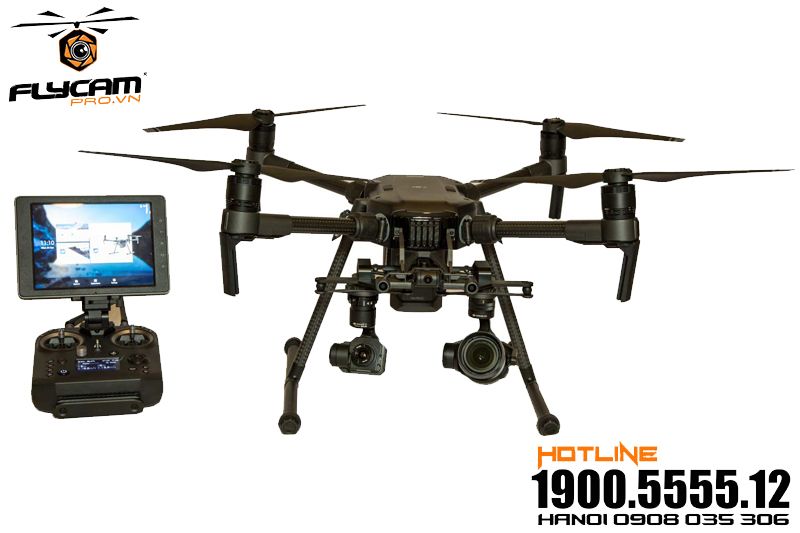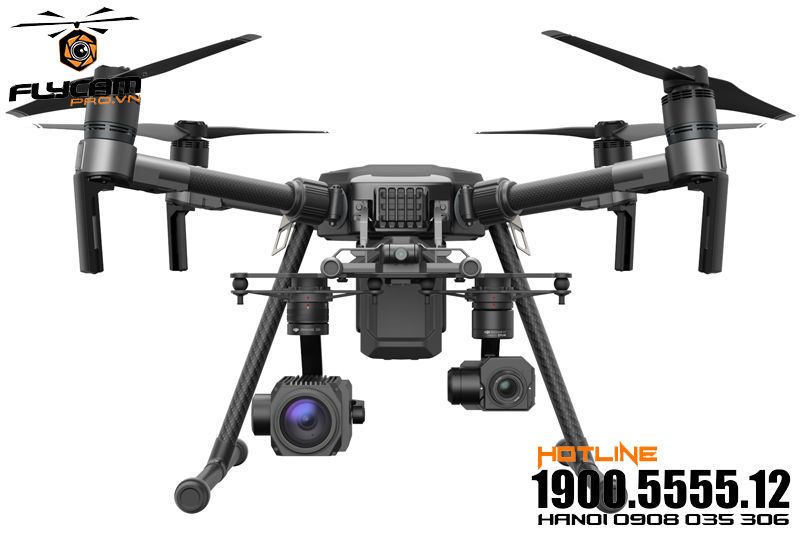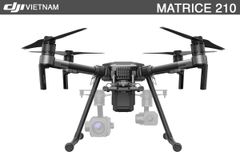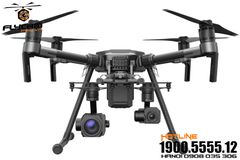
DJI MATRICE M210 V2.0 NEW | UAV CHỐNG NƯỚC ( KHÔNG GIMBAL CAMERA )
- Mã Sản Phẩm 000M210
![]() 1900.5555.12
1900.5555.12
![]() 0901.5555.12 | 0901.866.767
0901.5555.12 | 0901.866.767
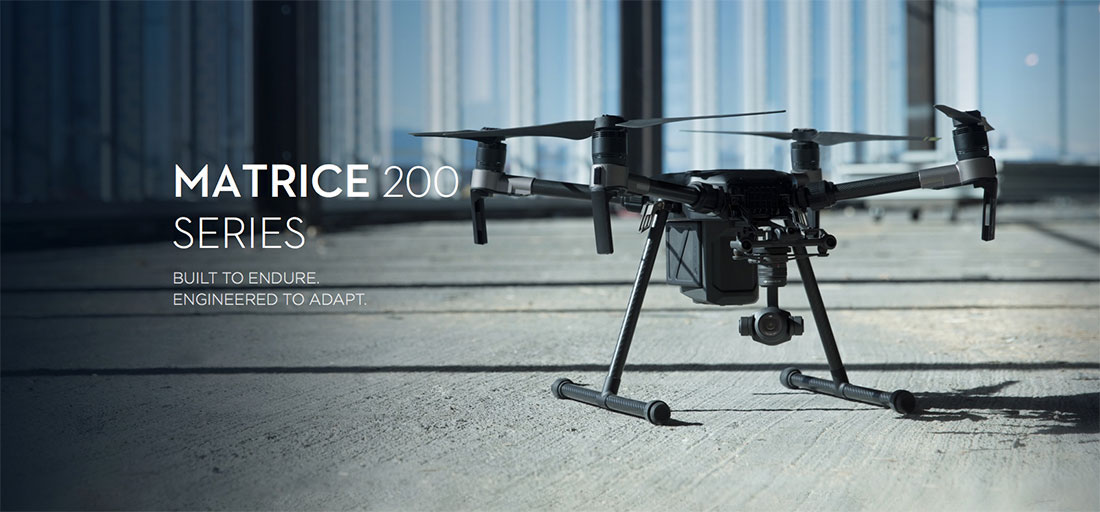
DJI Matrice M210 Máy bay camera
DJI VN xin giới thiệu DJI Matrice 200 series, thiết bị thương mại đáng tin cậy và linh hoạt nhất mà DJI từng sản xuất.

Được tạo ra bởi những kỹ sư hàng đầu về drone, Matrice 200 series được tạo ra dành cho những doanh nghiệp có yêu cầu vượt quá sự mong đợi. Được thiết kế với hệ thống sử dụng 2 pin cùng nhau và thời gian bay được 32 phút.

Matrice M210 còn được trang bị thêm những camera nhu Zenmuse X4S, X5S, Z30 zoom camera hoặc camera nhiệt XT. Với những FPV camera được trang bị từ trước, người lái có được hình ảnh chính xác nhất từ vị chí trước của thiết bị để có thể bay qua những địa hình phức tạp nhất.


Matrice M210 có thể lắp 2 gimbal cùng lúc để mang lại những thông tin chính xác nhất, để có thể chụp 2 giữ liệu hình ảnh cùng 1 lúc. Thiết bị cũng có thể lắp camera trên đỉnh để thu thập thông tin ở những cơ sở hạ tầng thiết yếu.

Với thiết kế có thể gập lại, Matrice M210 có thể theo bạn mọi nơi và sẵn sàng cất cánh chỉ trong vài phút, với chế độ tự phát nhiệt giúp Matrice có thể hoặt động tốt ở nhiệt dộ âm độ C.


Với hệ thống tự do điều khiển, mọi lo lắng về độ ăn toàn và tin cậy chỉ là quá khứ. Được trang bị lazer censor bên trên giúp thiết bị nhận biết vật cản bên trên và hệ thống stereo phát hiện chướng ngại vật dưới mặt đất và phía trước.



THÔNG SỐ KĨ THUẬT
M210
AIRCRAFT
| Model | M210 |
|---|---|
| Package Dimensions | 31.1×15.4×11.4inch (790×390×290mm) |
| Dimensions (unfolded) | 34.9×34.6×14.9 inch (887×880×378 mm) |
| Dimensions (folded) | 28.2×8.7×9.3 inch (716×220×236 mm) |
| Folding Method | Folded Inward |
| Diagonal Wheelbase | 25.3 inch (643 mm) |
| Number of Batteries | 2 |
| Weight (TB50) | Approx.3.84kg (with two standard batteries ) |
| Weight (TB55) | Approx.4.57kg (with two standard batteries ) |
| Max Takeoff Weight | 6.14KG |
| Max Payload (2 TB50) | Approx.2.3kg (with two standard batteries ) |
| Max Payload (2 TB55) | Approx.1.57kg (with two standard batteries ) |
| Hovering Accuracy (during safe flights) | Vertical: ±0.5,Downward Vision System enabled: ±0.1 Horizontal: ±1.5,Downward Vision System enabled: ±0.3 |
| Max Angular Velocity | Pitch: 300° /s;Yaw:150° /s |
| Max Pitch Angle (Dual Downward Gimbals) | P Mode: 25°(Forward Vision System enabled: 25°); A Mode: 25°;S Mode: 30° |
| Max Pitch Angle(Single Upward/Downward Gimbal) | P Mode: 30°(Forward Vision System enabled: 25°); A Mode: 30°;S Mode: 35° |
| Max Ascent Speed | 16.4 ft/s (5 m/s) |
| Max Descent Speed | Vertical: 9.8 ft/s (3 m/s) |
| Max Speed(Dual Downward Gimbals) | S Mode: 40.3mph (64.8kph) P Mode: 38mph (61.2kph) A Mode: 38mph (61.2kph) |
| Max Speed (Single Upward/Downward Gimbals) | S Mode: 51.4mph (82.8kph) P Mode: 38mph (61.2kph) A Mode: 51.4mph(82.8kph) |
| Max Service Ceiling Above Sea Level | 1.86 miles (3000 m) |
| Max Wind Resistance | 39.4 ft/s (12 m/s) |
| Max Flight Time(No Payload, with TB50) | 27min |
| Max Flight Time(No Payload, with TB55) | 38min |
| Max Flight Time(Full Payload, with TB50) | 13min |
| Max Flight Time(Full Payload, with TB55) | 24min |
| Motor Model | DJI 3515 |
| Propeller Model | 1760S |
| Operating Temperature | -4° to 113° F (-20° to 45° C) |
| IP Rating | IP43 |
GIMBAL INSTALLATION
| Downward Gimbal Mount | Supported |
|---|---|
| Upward Gimbal Mount | Supported |
| Downward Dual Gimbal | Supported |
CHARGER
| Model | IN2C180 |
|---|---|
| Voltage | 26.1 V |
| Rated Power | 180 W |
FORWARD VISION SYSTEM
| Obstacle Sensing Range | 2.3-98.4 feet (0.7-30 m) |
|---|---|
| FOV | Horizontal 60°,Vertical 54° |
| Operating Environment | Surfaces with clear patterns and adequate lighting (> 15 lux) |
DOWNWARD VISION SYSTEM
| Velocity Range | <32.8 ft/s (10 m/s) at height of 6.56 feet (2 m) |
|---|---|
| Altitude Range | <32.8 feet (10 m) |
| Operating Range | <32.8 feet (10 m) |
| Operating Environment | Surfaces with clear patterns and adequate lighting (> 15 lux) |
| Ultrasonic Sensor Operating Range | 0.33-16.4 feet (10-500 cm) |
| Ultrasonic Sensor Operating Environment | Non-absorbing material, rigid surface (thick indoor carpeting will reduce performance) |
GIMBALS
| Compatible Gimbals | Zenmuse X4S Zenmuse X5S Zenmuse Z30 Zenmuse XT |
|---|
BATTERY
| Model | TB50 |
|---|---|
| Capacity | 4280 mAh |
| Voltage | 22.8V |
| Battery Type | LiPo 6S |
| Energy | 97.58 Wh |
| Net Weight | Approx. 520 g |
| Operating Temperature | -20°C to 45° C |
| Storage Temperature | Storage Temperature Less than 3 months: -4° to 113° F (-20° to 45° C) More than 3 months: 72° to 82° F (22° to 28° C) |
| Charging Temperature | 41° to 104° F (5° to 40° C) |
| Max Charging Power | 180 W |
| Model | TB55 |
| Capacity | 7660 mAh |
| Voltage | 22.8V |
| Battery Type | LiPo 6S |
| Energy | 176.93Wh |
| Net Weight | Approx. 885 g |
| Operating Temperature | -4° to 113° F (-20° to 45° C) |
| Storage Temperature | Less than 3 months: -20° C to 45° C More than 3 months: 22° C to 28° C |
| Charging Temperature | 41° to 104° F (5° to 40° C) |
| Max Charging Power | 180 W |
DJI GO 4 APP
| Name | DJI GO 4 |
|---|---|
| Mobile Device System Requirements | iOS 9.0 or later,Android 4.4.0 or later |
| Supported Mobile Devices | iOS:iPhone 5s, iPhone SE, iPhone 6, iPhone 6 Plus, iPhone 6s, iPhone 6s Plus, iPhone 7, iPhone 7 Plus, iPad Air, iPad Air Wi-Fi + Cellular, iPad mini 2, iPad mini 2 Wi-Fi + Cellular, iPad Air 2, iPad Air 2 Wi-Fi + Cellular, iPad mini 3, iPad mini 3 Wi-Fi + Cellular, iPad mini 4 and iPad mini 4 Wi-Fi + Cellular. This app is optimized for iPhone 7, iPhone 7 Plus. Android:Samsung tabs 705c, Samsung S6, Samsung S5, Samsung NOTE4, Samsung NOTE3, Google Nexus 6p, Nexus 9, Google Nexus 7 II, Ascend Mate7, Huawei P8 Max, Huawei Mate 8, LG V20, Nubia Z7 mini, Sony Xperia Z3, MI 3, MI PAD, Smartisan T1. *Support for additional devices available as testing and development continues. |
UPWARD INFRARED SENSOR
| Obstacle Sensing Range | 0-16.4 feet (0-5 m) |
|---|---|
| FOV | ±5° |
| Operating Environment | Large, diffuse and reflective obstacles (reflectivity >10%) |
CENDENCE
| Type | GL800A |
|---|---|
| Operating Frequency | 2.400-2.483 GHz; 5.725-5.825 GHz |
| Max Transmitting Distance (unobstructed, free of interference) | 2.4 GHz: 4.3 miles (7 km, FCC); 2.2 miles (3.5 km, CE); 2.5 miles (4 km, SRRC) 5.8 GHz: 4.3 miles (7 km, FCC); 1.2 miles (2 km, CE); 3.1 miles (5 km, SRRC) |
| EIRP | 2.4 GHz: 26 dBm (FCC); 17 dBm (CE); 20 dBm (SRRC) 5.8 GHz: 28 dBm (FCC); 14 dBm (CE); 20 dBm (SRRC) |
| Power Supply | Extended Intelligent Battery (Model: WB37-4920mAh-7.6V) |
| Intelligent Battery | 4923 mAh LiPo |
| Charging | DJI charger |
| Output Power | 20 W (supplying power to DJI CS550 monitor) 12 W (without supplying power to monitor) |
| Video Output Ports | USB, HDMI, SDI |
| USB Supply Power | iOS: 1 A, 5.2 V (Max); Android: 1.5 A, 5.2 V (Max) |
| Dual User Capability | Master-and-Slave connection |
| Operating Temperature | -4 ° to 104 °F (-20 ° to 40 °C) |
| Storage Temperature | Less than 3 months: -4 ° to 113 °F (-20 °to 45 °C) More than 3 months: 72 °to 82 °F (22 °to 28 °C) |
| Charging Temperature | 32 ° to 104 °F (0 °to 40 °C) |
| Charging Time | About 2 hours and 24 minutes (using a 180 W charger) |
| Supply Power Time | About 4 hours (only Master remote controller function enabled and without supplying power to monitor) |
| Weight | 1041 g |








M210 RTK
AIRCRAFT
| Model | M210 RTK |
|---|---|
| Package Dimensions | 31.1×15.4×11.4inch (790×390×290mm) |
| Dimensions (unfolded) | 34.9×34.6×16.1 inch (Unfolded, 887×880×408 mm), |
| Dimensions (folded) | 28.2×11.3×9.3 inch (Folded, 716×287×236 mm) |
| Folding Method | Folded Inward |
| Diagonal Wheelbase | 25.3 inch (643 mm) |
| Number of Batteries | 2 |
| Weight (TB50) | Approx. 4.42 kg |
| Weight (TB55) | Approx. 5.51 kg |
| Max Takeoff Weight | 6.14 kg |
| Max Payload (2 TB50) | Approx.1.72 kg (with two standard batteries ) |
| Max Payload (2 TB55) | Approx.0.99 kg (with two optional batteries) |
| Hovering Accuracy (P-mode with GPS) | Vertical: ±1.64 feet (0.5 m) or ±0.33 feet (0.1 m, Downward Vision System enabled) or ±0.33 feet (0.1 m, RTK enabled) Horizontal: ±4.92 feet (1.5 m) or ±0.98 feet (0.3 m, Downward Vision System enabled) or ±0.33 feet (0.1 m, RTK enabled) |
| Max Angular Velocity | Pitch: 300°/s, Yaw: 150°/s |
| Max Pitch Angle(Dual Downward Gimbals) | P Mode: 25°(Forward Vision System enabled: 25°); A Mode: 25°;S Mode: 30° |
| Max Pitch Angle(Single Upward/Downward Gimbal) | P Mode: 30°(Forward Vision System enabled: 25°); A Mode: 30°;S Mode: 35° |
| Max Ascent Speed | 16.4 ft/s (5 m/s) |
| Max Descent Speed | Vertical: 9.8 ft/s (3 m/s) |
| Max Speed (Dual Downward Gimbals) | S Mode: 40.3mph (64.8kph) P Mode: 38mph (61.2kph) A Mode: 38mph (61.2kph) |
| Max Speed (Single Upward/Downward Gimbal) | S Mode: 51.4mph (82.8kph) P Mode: 38mph (61.2kph) A Mode: 51.4mph(82.8kph) |
| Max Service Ceiling Above Sea Level | 1.86 miles (3000 m) |
| Max Wind Resistance | 39.4 ft/s (12 m/s) |
| Max Flight Time(No Payload, with TB50) | 23min |
| Max Flight Time(No Payload, with TB55) | 32min |
| Max Flight Time(Full Payload, with TB50) | 13min |
| Max Flight Time(Full Payload, with TB55) | 24min |
| Motor Model | DJI 3515 |
| Propeller Model | 1760S |
| Operating Temperature | -4° to 113° F (-20° to 45° C) |
| IP Rating | IP43 |
GIMBAL INSTALLATION
| Downward Gimbal Mount | Supported |
|---|---|
| Upward Gimbal Mount | Supported |
| Downward Dual Gimbal | Supported |
CHARGER
| Model | IN2C180 |
|---|---|
| Voltage | 26.1 V |
| Rated Power | 180 W |
FORWARD VISION SYSTEM
| Obstacle Sensing Range | 0.7 - 30 m; |
|---|---|
| FOV | Horizontal 60°,Vertical 54° |
| Operating Environment | Surfaces with clear patterns and adequate lighting (> 15 lux) |
DOWNWARD VISION SYSTEM
| Velocity Range | <32.8 ft/s (10 m/s) at height of 6.56 feet (2 m) |
|---|---|
| Altitude Range | <32.8 feet (10 m) |
| Operating Range | <32.8 feet (10 m) |
| Operating Environment | Surfaces with clear patterns and adequate lighting (> 15 lux) |
| Surfaces with clear patterns and adequate lighting (> 15 lux) | 0.33-16.4 feet (10-500 cm) |
| Ultrasonic Sensor Operating Environment | Non-absorbing material, rigid surface (thick indoor carpeting will reduce performance) |
GIMBALS
| Compatible Gimbals | Zenmuse X4S Zenmuse X5S Zenmuse Z30 Zenmuse XT |
|---|
BATTERY
| Model | TB50 |
|---|---|
| Capacity | 4280 mAh |
| Voltage | 22.8V |
| Battery Type | LiPo 6S |
| Energy | 97.58 Wh |
| Net Weight | Approx. 520g |
| Operating Temperature | -4° to 113° F (-20° to 45° C) |
| Storage Temperature | Less than 3 months: -4° to 113° F (-20° to 45° C) More than 3 months: 72° to 82° F (22° to 28° C) |
| Charging Temperature | 41° to 104° F (5° to 40° C) |
| Max Charging Power | 180 W |
| Model | TB55 |
| Capacity | 7660 mAh |
| Voltage | 22.8V |
| Battery Type | LiPo 6S |
| Energy | 176.93Wh |
| Net Weight | 885g |
| Operating Temperature | -20°C to 45° C |
| Storage Temperature | Less than 3 months: -20° C to 45° C More than 3 months: 22° C to 28° C |
| Charging Temperature | 41° to 104° F (5° to 40° C) |
| Max Charging Power | 180 W |
DJI GO 4 APP
| Name | DJI GO 4 |
|---|---|
| Mobile Device System Requirements | iOS 9.0 or later,Android 4.4.0 or later |
| Supported Mobile Devices | iOS:iPhone 5s, iPhone SE, iPhone 6, iPhone 6 Plus, iPhone 6s, iPhone 6s Plus, iPhone 7, iPhone 7 Plus, iPad Air, iPad Air Wi-Fi + Cellular, iPad mini 2, iPad mini 2 Wi-Fi + Cellular, iPad Air 2, iPad Air 2 Wi-Fi + Cellular, iPad mini 3, iPad mini 3 Wi-Fi + Cellular, iPad mini 4 and iPad mini 4 Wi-Fi + Cellular. This app is optimized for iPhone 7, iPhone 7 Plus. Android:Samsung tabs 705c, Samsung S6, Samsung S5, Samsung NOTE4, Samsung NOTE3, Google Nexus 6p, Nexus 9, Google Nexus 7 II, Ascend Mate7, Huawei P8 Max, Huawei Mate 8, LG V20, Nubia Z7 mini, Sony Xperia Z3, MI 3, MI PAD, Smartisan T1. *Support for additional devices available as testing and development continues. |
UPWARD INFRARED SENSOR
| Obstacle Sensing Range | 0-16.4 feet (0-5 m) |
|---|---|
| FOV | ±5° |
| Operating Environment | Large-sized object with diffuse reflecting surface or high reflective rate (>10%) |
CENDENCE
| Type | GL800A |
|---|---|
| Operating Frequency | 2.400-2.483 GHz; 5.725-5.825 GHz |
| Max Transmitting Distance (unobstructed, free of interference) | 2.4 GHz: 4.3 miles (7 km, FCC); 2.2 miles (3.5 km, CE); 2.5 miles (4 km, SRRC) 5.8 GHz: 4.3 miles (7 km, FCC); 1.2 miles (2 km, CE); 3.1 miles (5 km, SRRC) |
| EIRP | 2.4 GHz: 26 dBm (FCC); 17 dBm (CE); 20 dBm (SRRC) 5.8 GHz: 28 dBm (FCC); 14 dBm (CE); 20 dBm (SRRC) |
| Power Supply | Extended Intelligent Battery (Model: WB37-4920mAh-7.6V) |
| Intelligent Battery | 4923 mAh LiPo |
| Charging | DJI charger |
| Output Power | 20 W (supplying power to DJI CS550 monitor) 12 W (without supplying power to monitor) |
| Video Output Ports | USB, HDMI, SDI |
| USB Supply Power | iOS: 1 A, 5.2 V (Max); Android: 1.5 A, 5.2 V (Max) |
| Dual User Capability | Master-and-Slave connection |
| Operating Temperature | -4 ° to 104 °F (-20 ° to 40 °C) |
| Storage Temperature | Less than 3 months: -4 ° to 113 °F (-20 °to 45 °C) More than 3 months: 72 °to 82 °F (22 °to 28 °C) |
| Charging Temperature | 32 ° to 104 °F (0 °to 40 °C) |
| Charging Time | About 2 hours and 24 minutes (using a 180 W charger) |
| Supply Power Time | About 4 hours (only Master remote controller function enabled and without supplying power to monitor) |
| Weight | 1041 g |

AIRCRAFT
1.What cameras and gimbals is the M200 series compatible with?
2.Does the M200 series have an Obstacle Avoidance/FlightAutonomy system?
3.What is the difference between the M100, M200 and M600?
4.Is a case included with my M200 Series drone?
5.What is IP43 protection rating, and in what scenarios can the Matrice 200 series be protected under this rating?
Note: The protection rating may reduce or fail in case of folded-frame arms, exposed ports as a result of open cover, loose weatherproof shell top plugs, and if the aircraft is broken.
6.Can I use the Matrice 200 series on rainy days? And what are some factors to consider when flying in rainy weather?
1. DO NOT fold the frame arms in the rain. Make sure the port covers and Micro SD card slot cover are properly attached.
2. DO NOT turn the aircraft upside down. The angle of inclination of the aircraft body and the ground should not exceed ±60° when flying the aircraft on rainy days.
3. DO NOT use an external GPS module during flight.
4. Make sure the battery surfaces and battery compartment surfaces are dry before inserting the batteries.
5. Use TB50-M200 or TB55 Intelligent Flight Batteries. The batteries encased in the Inspire 2 are not waterproof.
6. Only the aircraft will be protected. The cameras are not covered by the protection rating.
7.Will I be covered if my aircraft incurs water damage?
8.Does my M200 Series drone to be regularly checked when flying in sandy environments?
9.Can I carry the M200 batteries on a commercial airplane?
10.What happens if one battery fails?
11.For the M210 RTK model, is there any extra setup required for this unit?
APPLICATIONS
1.I’m a filmmaker, is this the best option for me?
2.I’m a power line, telecom tower inspector and worry about interference affecting the safety of my inspection, which M200 Series model and payload will help me operate more safely?
3.My business is interested in integrating drones into our business, where can we learn more?
PAYLOADS
1.What cameras are compatible with the M200 series?
2.What dual gimbal configurations are supported by the M210 models?
| Left gimbal port | Right gimbal port |
|---|---|
| XT | X4S |
| X5S | |
| Z30 | |
| Z30 | X4S |
| X5S | |
| XT |
3.How do I mount an upward payload?
4.Can you fly with both the XT and Z30 at the same time?
5.Can you mount a camera upwards and downwards at the same time?
6.Can the Zenmuse XT camera be used with the M200 Series platform?
SOFTWARE
1.What mobile software programs are compatible with the M200 series?
2.What’s new in the DJI Pilot app?
3.What programs can I use for creating reproducible flight plans for automated flight?
4.Where can I learn more about DJI FlightHub?
OTHER
1.How long does it take to charge a remote controller? How long does it last on a full charge?
2.Does my M200 Series drone come with a Micro SD card?
3.What is the latency of the transmission system?
4.Can you use batteries charged at different levels?
5.Do I need to pair the batteries?
6.Does the M200 Series support the Adobe CinemaDNG and Apple ProRes?
7.Does the M200 have a RTH function?
8.How do I enable autofocus?



